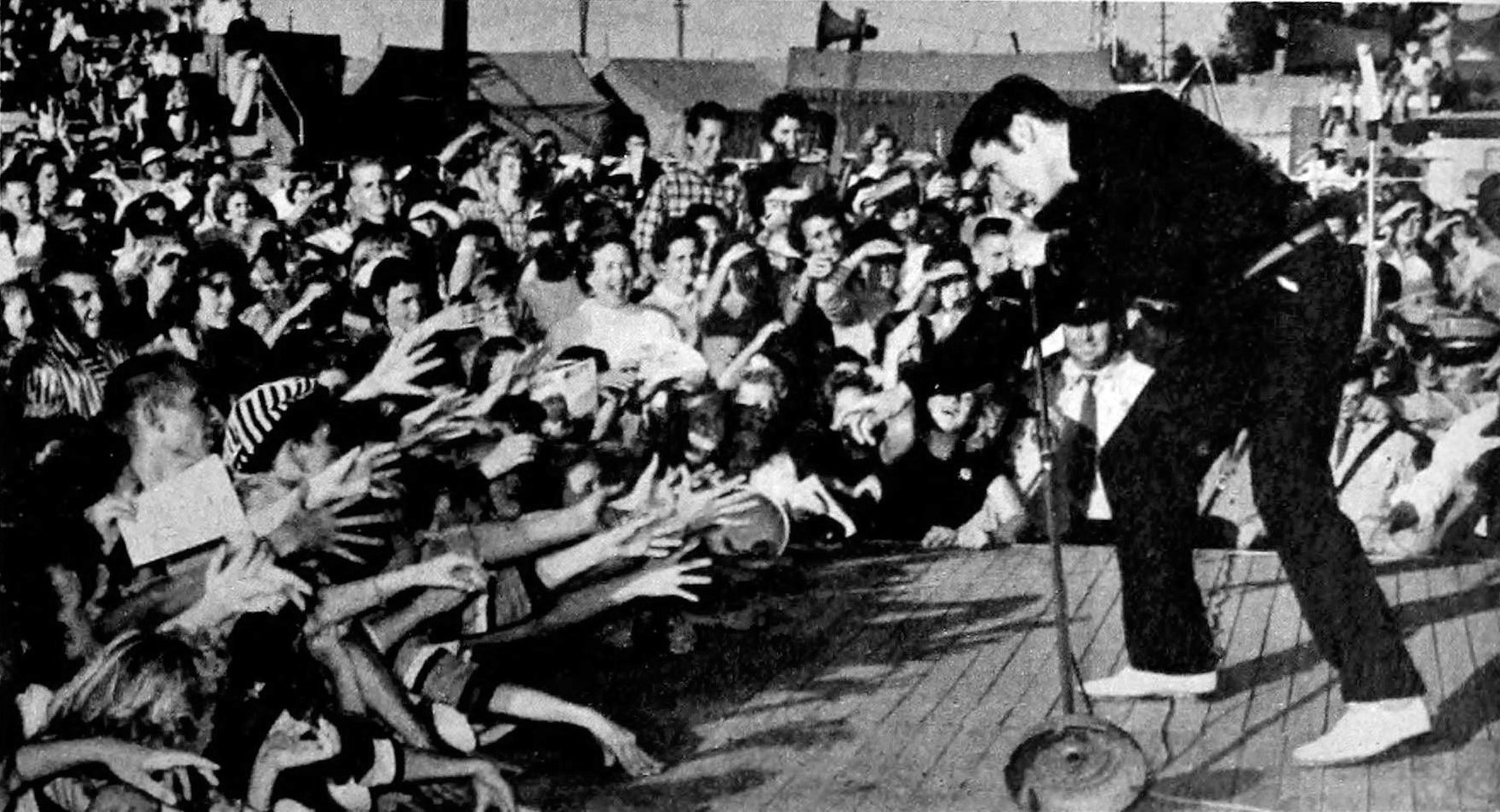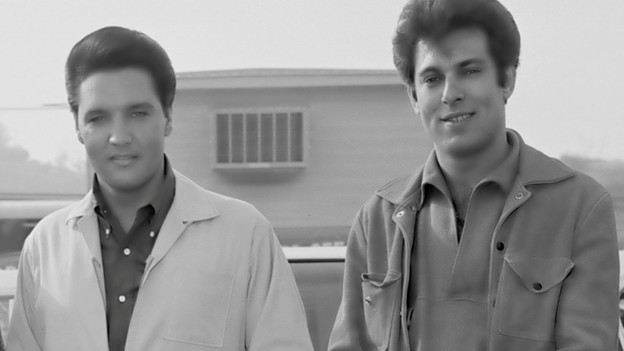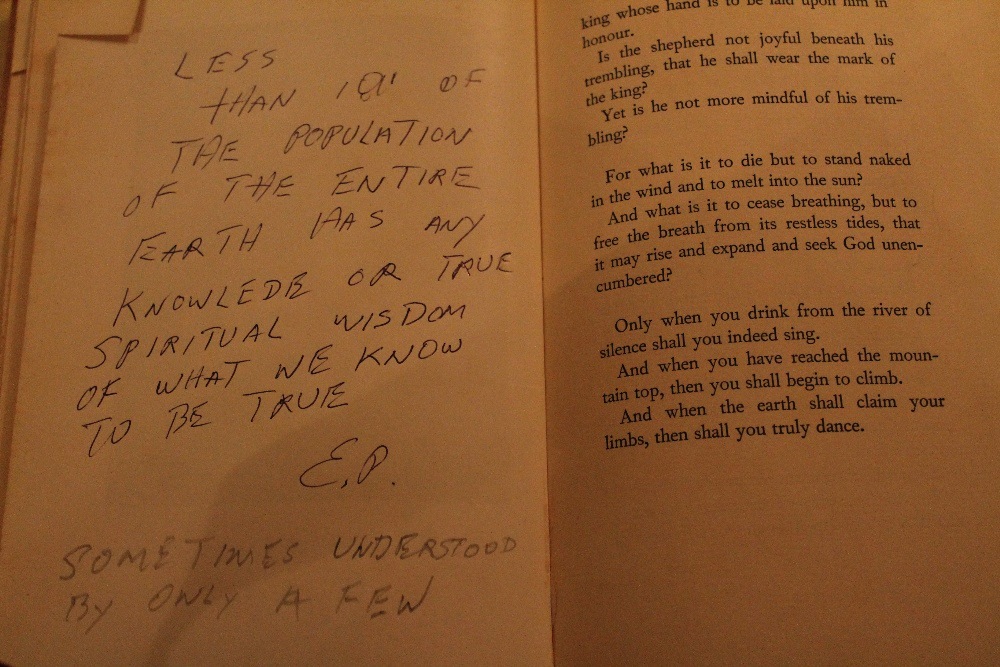Did you know that the King of Rock ’n’ Roll preferred to be called a spiritual seeker?
◊
Like the “flaming star” Elvis Presley sang about, he burst into the public’s consciousness in 1954 with a new sound in music, one that galvanized a worldwide army of teenagers with its frantic rhythms and incessant beat. His appeal was anchored by a rich baritone voice that growled and yelped a seeming dare at his listeners: were you “ready, ready, ready to Rock ’n’ Roll”? That these teens’ parents were scandalized by the raw carnality of Elvis’s sound, not to mention his shocking, gyrating appearance in the flesh, only made the music – and the singer – that much more appealing to the youth of America – and, indeed, the world.
In the two short, meteoric decades that followed, Elvis was marketed – and his image controlled – by his manager, “Colonel” Tom Parker. Parker wanted his client to appeal to the broadest possible slice of consumers of records and, starting soon after, Hollywood movies. By all appearances, Presley was a willing accomplice, making himself available for public appearances all over the U.S., releasing songs and albums, and appearing in a string of increasingly implausible and mediocre films produced simply to boost sales of the soundtrack albums.
Of the many songs and films Presley made, especially those in the 1950s and ’60s, prior to his final era as a Las Vegas headliner, it was hard – and, over time, increasingly harder – to discover precisely who this superstar was. Behind the costumes and stage makeup, who was the “real” Elvis Aron Presley? Was there even a “true” Elvis behind the public mask?
Listen to those closest to Elvis Presley – his friends and hangers-on – spin tales about the private Elvis, from his rise to stardom to his final days, in Elvis and the Memphis Mafia.
Presley’s Early Musical and Spiritual Influences in White – and Black – Southern Churches
Many sobriquets can be ascribed to Elvis Aron Presley – The King, Elvis the Pelvis, the Hillbilly Cat – but perhaps the least likely would be “Spiritual Seeker.” Yet this appellation is perhaps the most important and personal description of Elvis’s true, private identity.
Elvis was raised in the Southern Pentecostal church, but it wasn’t the gospel of a vengeful Old Testament God that he took away from his childhood. Instead, he rejected that church’s fundamentalist preaching and reliance on a strict, oppressive moralism – not to mention the racial prejudices inherent in a segregated congregation.
Though it may sound unique, the name “Elvis” is an anglicized version of the Irish name Ailbe. A Catholic parish of St. Elvis still exists in Pembrokeshire, Wales.
But the music, that irresistible Southern country gospel, was another thing altogether. Elvis stirred in an equal part of the much more raucous, soulful Black gospel music that he heard in the majority African American housing project in Memphis, Tennessee, where his family moved from Tupelo, Mississippi, in 1948, when he was 13.
He also snuck into the traveling revival services that dotted the Memphis landscape every week. Preachers would press into service the organist, the choir, and their tambourines to electrify the attendees and get them on their feet (which made it easier to get them to part with the coins and dollar bills they carried in their pockets).
Presley’s roots in the White church led him to employ the Jordanaires, a gospel singing group, for backup on his ballads and sacred music. At the same time, his “shake, rattle, and rolling” was influenced by the rhythm his holy-roller gospel experience imprinted on his soul.
For a while in the late 1960s and into the ’70s, Presley replaced the staid four-part harmonies of the all-White Jordanaires with the brassy Black soul stylings of the three-voice girl group called the Sweet Inspirations, who had also worked with Aretha Franklin.
Elvis Hits the Big Time as a Recording Artist
Presley graduated from high school in 1953 and soon after got a job in Memphis as a truck driver. His recording career was jump-started later that year after he recorded two songs – “My Happiness” and “That’s When Your Heartaches Begin” – in a cheap, do-it-yourself recording booth. He took the tapes from that session to a local music company, Sun Records, to have a single acetate record made as a gift for his mother, Gladys. (That acetate, which Elvis actually misplaced and never gave to Gladys, was eventually auctioned off for $300,000 in 2015.)
Sam Phillips, who owned Sun, heard the tape and realized that Elvis’s vocal style was precisely the sound he sought for his label. He had purportedly said, “If I can find a white man who can sing with a black man’s soul, I can make a million dollars.” Phillips found Presley and took the truck driver into his studio to record a handful of tracks, including “That’s All Right,” a Blues tune from 1946 originally recorded by Arthur Crudup. Presley sang it in a jump-blues style with a slapping, echoey bass line, and it became Presley’s first official recording. The rest is music history.
Presley soon outgrew Sun Records and its limited, regional distribution for RCA Records, one of the biggest recording companies in the U.S. His records were all going gold, and he became a cultural phenomenon. To say the least, his life – and lifestyle – changed dramatically. He was constantly in demand for touring, television appearances, and more.
In just three years or so, 1954 to 1957, Presley had pioneered a new musical style, upended the recording industry, inspired legions of imitators, and gone, almost literally, from rags to riches. He was able to lift his parents out of poverty and purchase the Memphis mansion called “Graceland,” a former plantation farmhouse.
Elvis in the '60s: ‘Is That All There Is’ to Fame?
By the time the 1960s rolled around, Elvis had successfully completed a two-year stint in the U.S. Army, stationed in Germany, and returned to a very comfortable lifestyle. He split his time between his Memphis mansion and a luxury rental in Bel Air, California, surrounded by his closest male friends – the “Memphis Mafia.” Joining them was a constantly evolving bevy of young women admirers, either in relationships with members of his “posse” or available to entertain the King of Rock ’n’ Roll whenever he sought companionship.
 Elvis thrilled crowds at his public appearances. (Source: Archive.org, via Wikimedia Commons)
Elvis thrilled crowds at his public appearances. (Source: Archive.org, via Wikimedia Commons)
As depicted in the 2023 biopic Priscilla, Presley made his long-standing girlfriend his wife in 1967, when she had turned 21. They had met in Germany when Priscilla was just 14, and their courtship was long and gradual. Elvis, 11 years her senior, had very traditional ideas about the role of a wife: Priscilla was installed as the queen of Graceland and rarely visited her betrothed on the West Coast. This arrangement gave the King the exact amount of freedom he desired in his marriage; Priscilla initiated divorce proceedings just five years later.
Presley never performed a concert outside the United States. Why? It all comes down to manager Tom Parker’s secret identity. An illegal immigrant, Parker (born Andreas van Kuyk) lived in the U.S. under a falsified passport; had he traveled with Presley outside the States, he likely would not have been allowed back in.
Given all the trappings of success Presley enjoyed – concerts in Vegas, films released nearly every year, songs on the charts – was he happy? Presley’s fame placed him in a virtual fishbowl, where every move he made in public was recorded by the press for a public starved for inside information about their favorite celebrity. However, his natural preference was to avoid overexposure to the fans. So, he retreated and had little to no unguarded interactions with the people outside his circle, except for the young women occasionally invited to party with him.
Most but not all of the “Memphis Mafia” hailed from that illustrious Mississippi River town. They were “mafioso” because they were both tight-knit and tight-lipped, and they kept all of Presley’s affairs under wraps (at least until some of them were fired from the entourage in 1977 and published the best-selling, tell-all book titled Elvis: What Happened?).
To better answer the question of Elvis’s inner frame of mind, let’s introduce one of the few Memphis mafiosos not from Tennessee: Elvis’s hairstylist and confidante, Larry Geller.

Duelling pompadours: Elvis Presley with Larry Geller (at right)
Larry Geller’s Role in Elvis’s Search for Spirituality
Larry Geller was a Los Angeles hairdresser to Hollywood’s male stars. Presley knew of Geller’s reputation and had an assistant contact the salon where he worked to ask Geller to do a house call. By all reports, Geller worked magic on Presley. In addition to thickening Elvis’s thin locks, he found a way to keep his famous pompadour from drooping during long film takes under hot studio lights. And, fatefully, he brought up a topic Presley was keen to discuss in a way that went over the heads of his usual compatriots: the existential search for meaning in life.
Despite how it appeared, Elvis Presley did not have naturally black tresses. One element of his hair routine from the ’50s onward was to take his natural sandy blond locks and dye them jet black every three weeks. He even used mascara to touch up his roots between dye jobs.
Despite his many albums of traditional Southern gospel hymns, Presley was much more ecumenical in his worldview than was traditional fire-and-brimstone Christianity. He didn’t reject Jesus and the New Testament, nor did he reject other religions. He wore golden necklaces anchored by both the Holy Cross and the Star of David, and while he never let his beliefs interfere with his record sales, he was open to even more esoteric spiritual beliefs, including Baha’i and Sufism.
But he rarely spoke about his beliefs publicly. Privately, he was open to expressing his interests if his audience was receptive. In 1959, he received a copy of The Prophet by Kahlil Gibran. This book became a steady seller among readers embarked on a spiritual search, particularly during the late 1960s and early ’70s. Gibran was a believer in Christian mysticism, and The Prophet is a work that combines the revolutionary beliefs of Friedrich Nietzsche, the pantheism of William Blake, and the spiritual beliefs of Sufism.
Presley purchased scores of copies of The Prophet throughout his life, marking copies with notes and other marginalia that expressed his spiritual beliefs and, even more so, his questions. Geller’s familiarity with Gibran’s work and his celebration of the ideas in The Prophet immediately drew Presley to him.
 A copy of The Prophet owned and annotated by Elvis Presley. (Source: Zero2Zenith, via Wikimedia Commons)
A copy of The Prophet owned and annotated by Elvis Presley. (Source: Zero2Zenith, via Wikimedia Commons)
Geller has stated that he and Presley spoke for hours the first time Geller cut his hair. He recalls that in that conversation, Presley said, “People take their lives for granted. I don’t. I’ve always wondered, Why me? Why did I become Elvis Presley,” referring to his fame, “out of the millions and millions of people?” Geller continued, “He was the biggest star in the world [but] there was something missing. There was a hole. And that was profound in itself.”
To solidify the bond Presley was feeling with his new friend, he offered Geller a full-time job on his staff at the end of their first meeting. Geller accepted, quitting his job that day and showing up the next morning at 8 a.m. to style Presley’s hair on the set of the movie Presley was working on, Roustabout (1964).
Geller stayed close to Presley till Elvis’s death in 1977. Even though he wasn’t popular with the rest of the Mafia, nor with Presley’s father, his wife, or even Colonel Parker, Geller supplied dozens of books to Presley, and the singer felt he could talk to him on matters that others in his inner circle couldn’t. Many of the Memphis Mafia believed Geller was just another believer in “California cult crap.” But, most importantly, Elvis was on board.
Elvis’s Sad and Lonely Death
Despite Geller’s close relationship with Presley, he completely struck out at having any impact on Elvis’s life choices beyond his spiritual belief system. Presley said he was against drugs, but he was very selective in how he defined the drugs he found objectionable. Presley was dependent on amphetamines to wake him up in the morning and on barbiturates to sleep at night. These drugs, and many others, were okay because, despite his abuse of them, they were prescribed by Elvis’s personal physician, George Nichopoulos, or “Dr. Nick.”
Elvis died in large part because of the adverse long-term effects of the drugs he took; his autopsy found that there were more than 10 different drugs in his system, all prescribed by Dr. Nick. Among the drugs were significant amounts of codeine, morphine, quaaludes, and valium, all depressants.
According to Geller, he was called soon after Presley’s body was found in a bathroom in his beloved Graceland. Geller said, “It’s almost like my soul ruptured.” Vernon, Elvis’s father, asked Geller to style his son’s hair for viewing in the coffin, and the hairdresser complied, getting each strand of hair positioned perfectly and touching up the gray at his roots.
Tragically, instead of Elvis it was Larry Geller who had the last word on his deceased friend. He said, “Elvis’s music and the force of his personality – and his soul – lives on.”
Ω
Kevin Martin is Senior Writer and Associate Editor for MagellanTV. A journalist and communications specialist for many years, he writes on various topics, including Art and Culture, Current History, and Space and Astronomy. He is the co-editor of My Body Is Paper: Stories and Poems by Gil Cuadros (City Lights) and resides in Glendale, California.
Title Image: Elvis Presley (background widened with Adobe Photoshop) (Source: Rene Walter, via Flickr)

